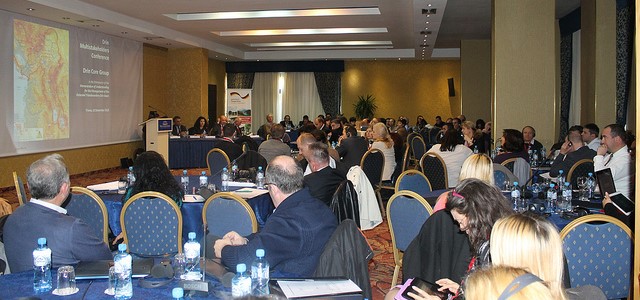Characteristics
One of the aspects that differentiates IWRM from more conventional water management practices is the involvement of stakeholders in the planning and implementation processes. Stakeholders are the people and organisations who may impact or be impacted by the outcomes of a decision. Stakeholder participation is critical to IWRM for multiple reasons: fundamentally, it is ethical; water is necessary for people to live and therefore those that depend on a water resource should have the right to participate in decisions regarding its management. Stakeholder participation in planning helps avoid mistakes in design that would make a project fail due to the local context. As well, involving stakeholders in planning will help foster ownership and ensure acceptance of a project. Additionally, effective stakeholder participation can facilitate communication and conflict resolution, and through active participation stakeholders gain understanding and feel agency. A key step is to analyse who the stakeholders are, what their interests, the roles they might play and then use this to inform the engagement and participation process. Stakeholder analysis is not an end in itself but an integral part of participation which is a core principle of IWRM.
The term stakeholder analysis refers to the processes and methods that aim at achieving effective and inclusive stakeholder participation. Stakeholder analysis is a tool to design a good stakeholder participation process, it is not an end in itself. It is valuable for understanding and addressing the dynamics between stakeholders to facilitate transparency and equity in decision-making for water management success. Stakeholder analysis falls under Modelling and Decision-Making Tools (C3) because it is a key part of making decisions, planning, and implementing an IWRM plan or project.
Stakeholder analysis includes identifying stakeholders, establishing their attributes or characteristic, investigating relationships between stakeholders, and prioritizing who should be involved to what extent in the project. Because stakeholder attributes and dynamics change over time and as a result of the project, stakeholder analysis should be an iterative process that starts at the beginning of a water management initiative and is revisited throughout, helping to guide the planning and implementation.
Many methods are used for the different aspects of stakeholder analysis. Some examples of methods for identifying stakeholders are focus groups, surveys, and interviews. Methods for investigating the relationships between stakeholders include actor-linkage matrices or social network analysis. Some examples of methods for establishing the attributes of different stakeholders are Q Methodology (a research method using the viewpoints of many subjects, it is a bottom-up approach), or Stakeholder Mapping (a top-down approach).
Stakeholder Mapping is effective for visualizing the attributes of stakeholders and consequently appropriate strategies for progress of the project. Alignment, Interest, Influence Mapping (AIIM) is an example of a Stakeholder Mapping technique. Mapping can also be done based on other stakeholder attributes including interest in the project, vulnerability, power, level of need, or degree of impact (how much the initiative could affect them).
There are many challenges to effective stakeholder participation, and many ways that stakeholder participation can be done ineffectively or with negative consequences. Ensuring that important stakeholder groups are not marginalized or left out requires careful attention and sensitivity. These considerations include: access to information; ability to participate in terms of time, money, or transportation; and cultural context. Also, managing power dynamics and conflicting opinions among stakeholders so that they do not jeopardize the process is difficult. Identifying stakeholders and assigning attributes must be done with sufficient information or participation (surveys, interviews, etc.) from stakeholders, otherwise certain stakeholders will likely have undue influence while others may be left out entirely. It is necessary to make judgements and decisions about what determines a stakeholder’s legitimacy in the project and how stakeholders can be appropriately represented in the participation process, and these judgements can be made poorly.
Challenges also include that thorough and inclusive stakeholder analysis is time consuming and costly. Many donor organisations require stakeholder analysis but the group implementing a project conducts only a “desk study” to meet this requirement while saving time and money. This should be avoided as it fails the fundamental purpose of stakeholder analysis.
Lessons learned
- Natural resource management projects have failed through inadequate understanding of stakeholder dynamics. Stakeholder analysis is a tool to help a project or initiative be successful by ensuring that important stakeholders are appropriately considered and planning accounts for dynamics among stakeholders.
- Stakeholder analysis can be misused to empower some and disempower others, or to improperly legitimize decisions.
- Conducting good stakeholder analysis without then doing meaningful stakeholder participation with the resulting information does not achieve IWRM. Similarly, if stakeholder analysis and stakeholder participation is conducted but those with the decision-making power are not willing to relinquish some of that power or do not act based on the stakeholders’ response, IWRM is not achieved.
- Stakeholder analysis can be done in a participatory or non-participatory manor, depending on the desired outcomes and the time and resources available.
- Difficulties can be encountered when trying to define, assess, and measure stakeholder “influence” or “interest” as instructions of how to do this is lacking in the literature.
- Using a method such as AIIM, that results in a visual representation, will show patterns in stakeholder attribute distribution and therefore is highly beneficial at the very beginning of the planning process.

